Physical Address
304 North Cardinal St.
Dorchester Center, MA 02124
Physical Address
304 North Cardinal St.
Dorchester Center, MA 02124
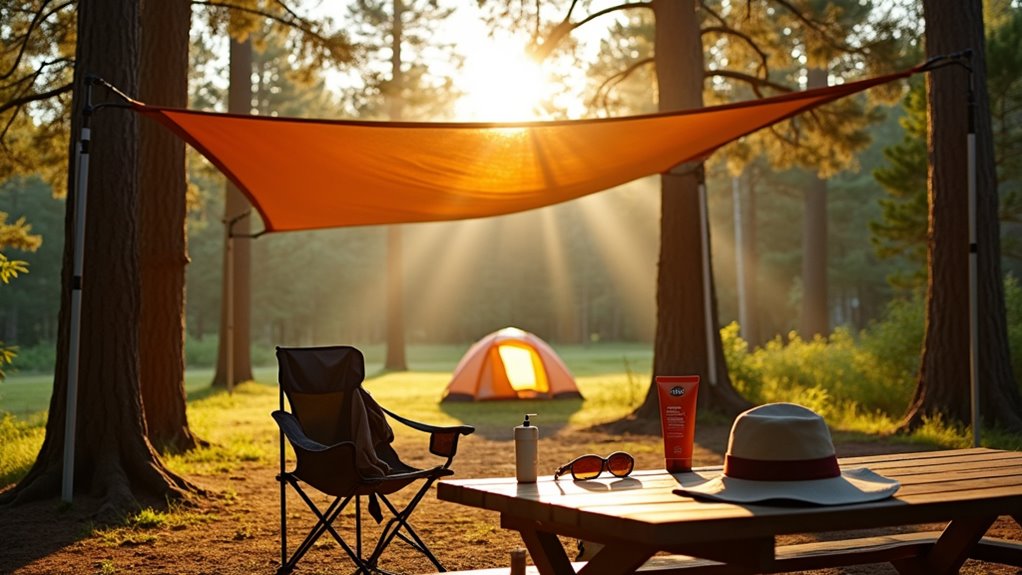
Protect yourself from dangerous UV rays while camping with these essential sun safety strategies that could save your trip from disaster.
When you’re “soaking up nature’s glow” during your camping adventure, you’re actually exposing yourself to potentially dangerous UV radiation that can quickly turn your outdoor getaway into a painful ordeal. While you can’t control the sun’s intensity, you’ve got more power than you think to shield yourself from its harmful effects. The key lies in understanding timing, gear selection, and strategic planning—three critical elements that’ll determine whether you return home with fond memories or regrettable burns.
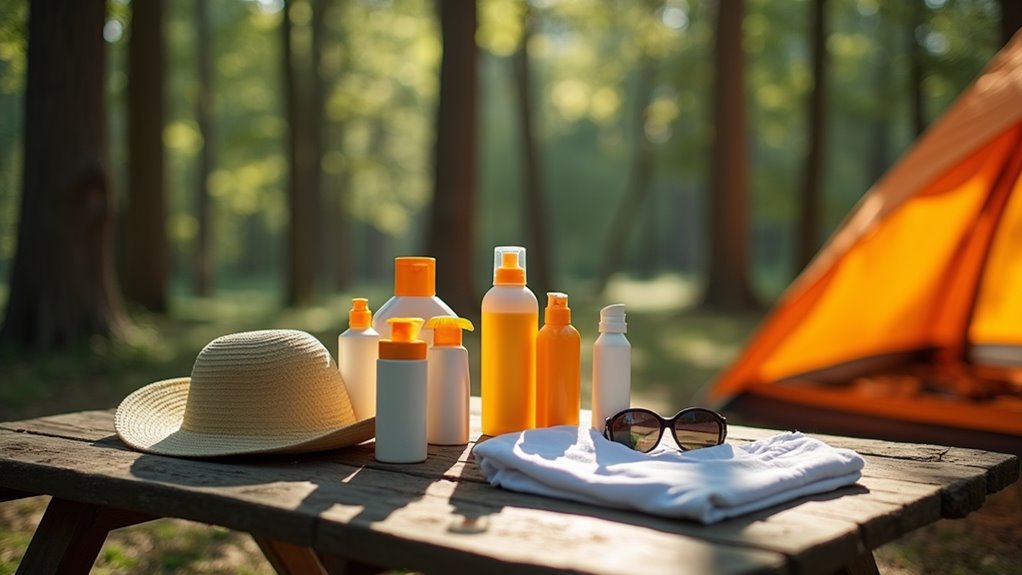
When you’re planning a camping trip, selecting the right sunscreen becomes crucial since you’ll likely spend most of your time outdoors with limited shade options.
Look for broad-spectrum protection with at least SPF 30 to shield against both UVA and UVB rays.
Water-resistant formulas work best for active camping since you’ll sweat and possibly encounter water activities.
Choose between mineral sunscreens containing zinc oxide or titanium dioxide for sensitive skin, or chemical sunscreens for easier application.
Stick formulas protect your face and lips effectively, while spray versions cover large body areas quickly.
Don’t forget reef-safe options if you’re camping near water bodies.
Pack extra bottles since you’ll need frequent reapplication every two hours, especially after swimming or heavy sweating during hiking and outdoor activities.
Remember that sun safety tips extend beyond just sunscreen selection and should be part of your comprehensive camping preparation strategy.
While sunscreen provides essential protection, your clothing choices can serve as your first line of defense against harmful UV rays during camping adventures.
Opt for long-sleeved shirts and pants made from tightly woven fabrics with UPF ratings when possible. Dark colors and synthetic materials like polyester offer better protection than light colors and cotton.
Dark synthetic fabrics with tight weaves and UPF ratings provide superior UV protection compared to light-colored cotton clothing.
Don’t forget your extremities. Wide-brimmed hats protect your face, neck, and ears more effectively than baseball caps. Choose hats with at least four-inch brims all around.
UV-blocking sunglasses shield your eyes and surrounding skin from damage.
Consider lightweight, breathable fabrics that won’t make you overheat. Many outdoor brands now offer clothing specifically designed for sun protection that’s both functional and comfortable for active camping.
Just as thoughtful planning goes into creating a camp kitchen that meets everyone’s needs, selecting the right sun-protective gear requires considering each camper’s preferences and activities.
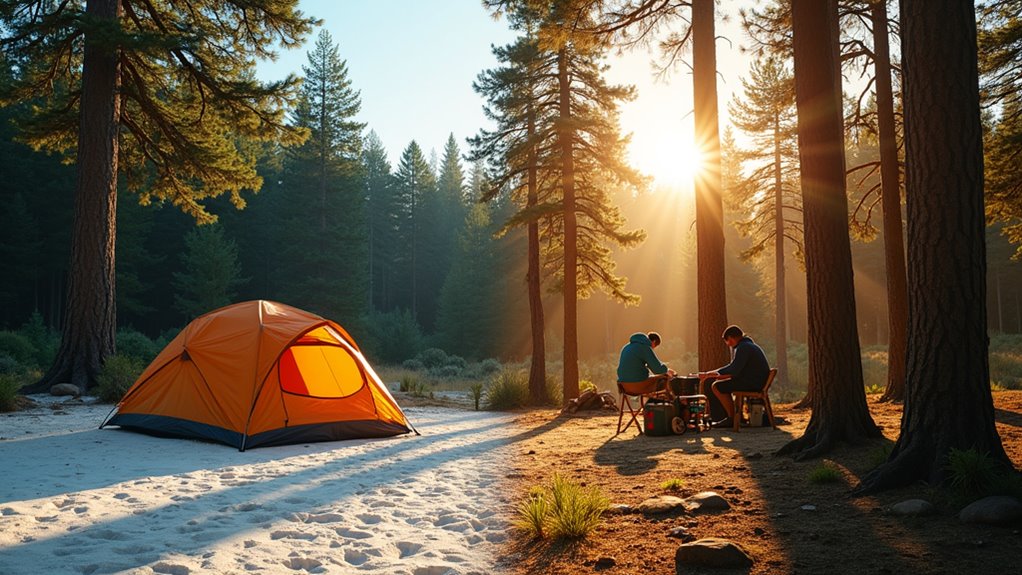
Even though you’re enthusiastic to explore during your camping trip, the sun’s rays are most intense between 10 AM and 4 PM, making this the riskiest time for UV exposure. Plan your hiking, fishing, and outdoor adventures for early morning or late afternoon instead. You’ll not only dodge harmful rays but also enjoy cooler temperatures and better wildlife viewing opportunities.
Use midday hours for activities in shaded areas like setting up camp under trees, organizing gear inside your tent, or taking a well-deserved nap. If you must be active during peak hours, stick to heavily wooded trails or areas with natural shade.
Consider indoor camp activities like reading, journaling, or meal prep. This simple scheduling adjustment dramatically reduces your sun exposure risk. If you’re winter camping with an RV, you can easily retreat inside your vehicle during peak sun hours to avoid UV exposure while still enjoying the outdoors.
Since natural shade isn’t always available at every campsite, you’ll need to create your own protection from the sun’s harsh rays. Pack a large tarp or canopy that you can string between trees or poles to establish a shaded area for cooking, eating, and relaxing.
Position your tent’s entrance facing away from the sun’s path to minimize interior heat buildup.
Use reflective emergency blankets or tarps to redirect sunlight away from your campsite.
Set up your camp kitchen and seating area in the shadiest spot available, even if it means adjusting your initial layout.
Consider bringing a pop-up shelter or beach umbrella for instant shade during activities like fishing or reading.
Creating multiple shaded zones gives you sun-safe options throughout the day.
Just as you research travel insurance options before a trip, take time to plan your shade strategy before heading out to ensure maximum protection from harmful UV rays.
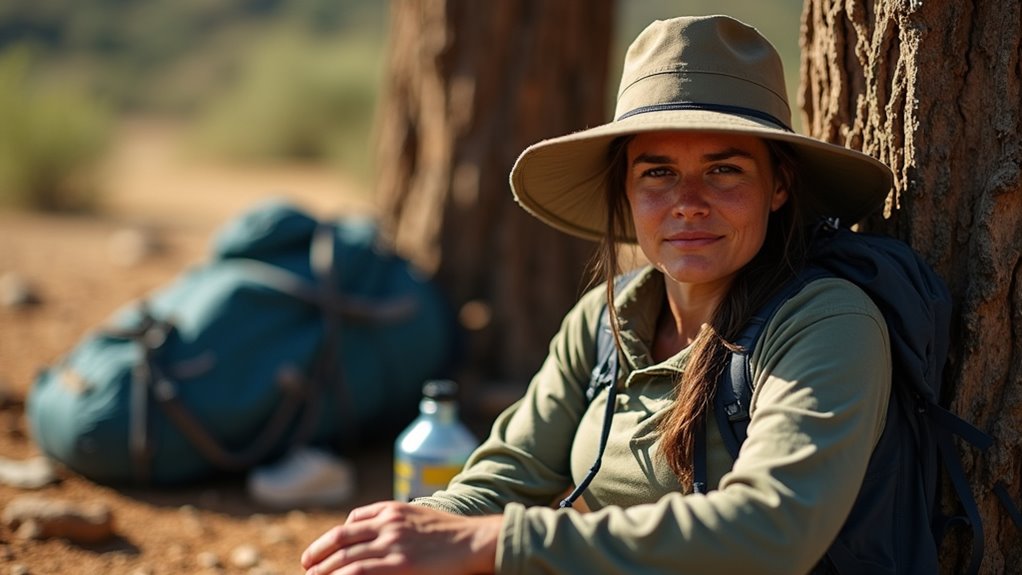
Beyond creating physical barriers against the sun, your body’s internal cooling system requires constant fuel to function properly in hot outdoor conditions. You’ll need to drink water consistently throughout the day, not just when you feel thirsty. Aim for clear or light yellow urine as your hydration gauge.
Watch for heat exhaustion warning signs: heavy sweating, weakness, nausea, headache, and dizziness. If you experience these symptoms, move to shade immediately and sip water slowly.
Heat stroke is more serious—look for hot, dry skin, confusion, and rapid pulse. This requires emergency medical attention.
Keep electrolyte packets handy for extended outdoor activities, and avoid alcohol since it accelerates dehydration. Your camping experience depends on recognizing these signals early.
Plus, be aware that certain insects are more active during hot weather and can pose health risks, so protecting yourself from insect bites becomes even more crucial when camping in sunny conditions.
How often do you think about the delicate skin around your eyes while you’re setting up camp or hiking trails? Your face and eyes need serious protection from UV rays that reflect off water, sand, and snow—intensifying sun exposure during outdoor adventures.
Wear wraparound sunglasses with 100% UV protection to shield your eyes and surrounding skin. Look for lenses labeled UV400 or “blocks 99-100% of UV rays.” Polarized lenses reduce glare from reflective surfaces like lakes and rocks.
Don’t forget a wide-brimmed hat that covers your face, ears, and neck. Baseball caps leave your ears and neck vulnerable.
Apply broad-spectrum sunscreen with SPF 30+ to your face, including often-missed spots like your eyelids, nose bridge, and behind your ears. Reapply every two hours.
If you’re camping near water for activities like fishing, remember that water surfaces create additional glare and UV reflection that can intensify sun exposure even when you’re wearing a hat and sunglasses, so consider used boat rental options with built-in shade structures for extended water activities.
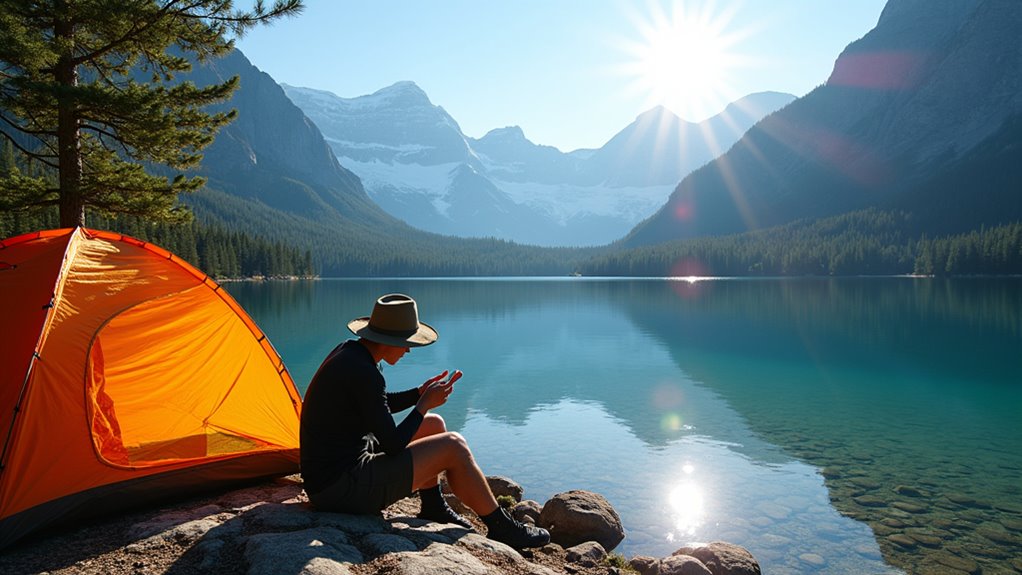
While most campers understand basic sun protection, high-altitude and waterside environments create dangerously deceptive conditions that catch even experienced outdoors enthusiasts off guard. You’ll encounter 25% more UV radiation for every 3,000 feet of elevation gained, making sunburn happen twice as fast at mountain campsites.
Water amplifies this risk by reflecting up to 15% of UV rays back at you, essentially doubling your exposure from below.
Water reflects UV rays upward, creating a hidden second source of sun exposure that doubles your radiation risk from underneath.
Snow creates the most extreme conditions, reflecting 80% of UV radiation and causing painful burns on your chin, nostrils, and inside your ears. You’ll need SPF 30+ sunscreen, wraparound sunglasses, and wide-brimmed hats in these environments.
Reapply sunscreen every hour near water or snow, not every two hours like usual camping conditions. Senior campers should take extra precautions with sun protection, as aging skin becomes more vulnerable to UV damage and takes longer to heal from sunburn injuries.
You’ve heard that a little sun exposure is healthy, and that’s true—your body needs vitamin D. But here’s the reality: you can get adequate vitamin D from just 10-15 minutes of morning sun. Don’t let this justify skipping protection during your camping trip. The risks of prolonged UV exposure far outweigh the benefits. Stick to your sunscreen routine, protective clothing, and shade-seeking habits. Your skin will thank you long after you’ve returned home.